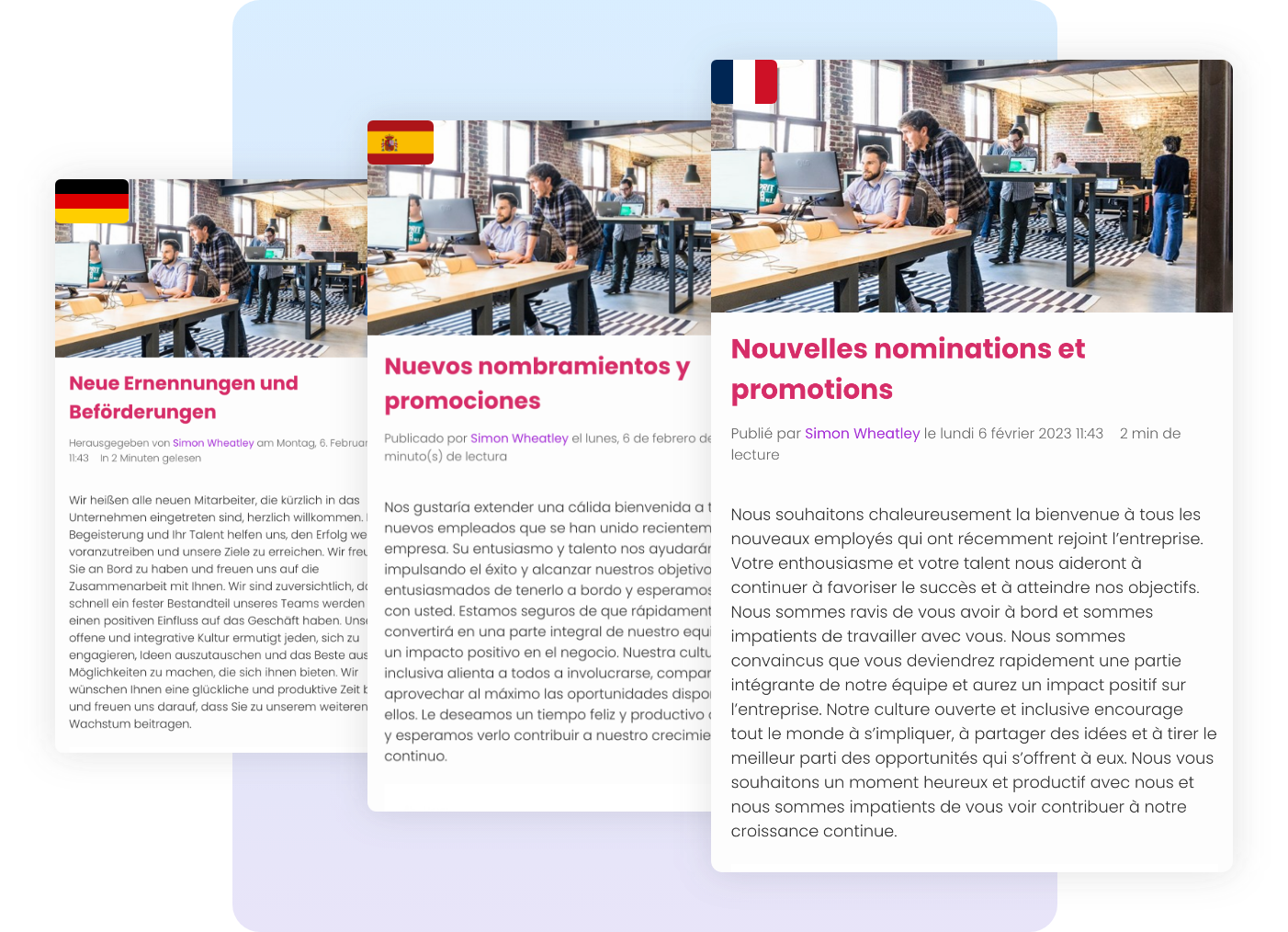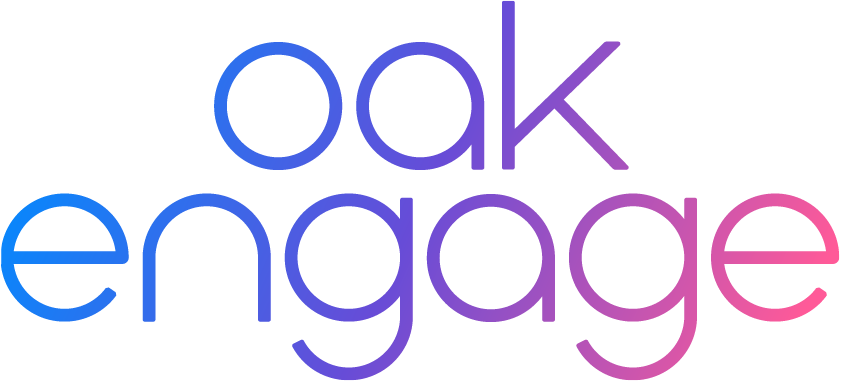Considering internal audiences in your communications strategy is essential for keeping everyone aligned, connected and engaged. When each team understands their role and feels informed, productivity improves and job satisfaction levels increase. Equipping your internal teams with the right information and tools not only supports their individual performance but also drives progress toward your wider business goals.
In this article we’ll show you how to build your internal audience segments because it is essential for ensuring your messages resonate with all employees, no matter their job type or location.
What are internal audiences?
Within your organisation, your employee base will make up a range of internal audiences that you need to consider when developing your internal comms strategy.
Things to consider when segmenting your audience are:
Job type
Desk-based, remote and deskless or frontline workers will all have different needs when it comes to internal communications.
Desk-based employees may want to connect with colleagues who work across different sites to see the good work others are doing. We all know too well how quickly our inbox can fill up and how easily we can ignore or lose emails when workload piles up.
Remote colleagues are likely to have the same issues, perhaps even more so because it could be the only way of keeping them in the loop. Email fatigue is real and can be exacerbated when they don’t feel relevant, such as office events or local activities. Find a way to differentiate your remote colleagues from your office based staff.
On the other hand, frontline colleagues may not even have a work email address or work-issued device. This means it’s common for frontline workers to rely on updates via their managers cascading information or on staffroom notice boards.
Recommended reading 📖: How to engage deskless workers
Digital literacy
The digital literacy of your workforce may also be an important factor to consider when thinking about your internal audiences. For example, your digital natives may find a new employee app intuitive and easy to use, perhaps engaging more with interactive features. Our Gen Z vs Millennial report found that 73% of Gen Z are frustrated with outdated technology in the workplace. As such, introducing an employee app that caters to your digital natives would be a great way to ensure they are receiving and engaging with workplace comms.
Remember, not everyone in your workforce will be comfortable with new apps, or at least it may take them longer to adopt it.
Some employees may be more cautious about downloading a work related app onto their personal phone. Your comms strategy needs to be tailored to each of your internal audiences to promote the benefits of using an employee app and how it will make things easier for them, such as viewing their payslips, booking time off or checking their rota.
Job role
Let’s look at how to create internal communications audience personas based on job role.
Your frontline staff will use the company intranet software differently to the HR team. Your warehouse colleagues will need to see different updates to your finance team. Tailoring comms to each internal audience means that you can be certain only the relevant people see the relevant updates and you can grant permissions to people based on their role, seniority or department.
Here are a few examples:
Front of house restaurant staff need access to:
- Policies and procedures for customer experience, cash management and uniform
- Self-service tools like checking rotas, payslips or booking annual leave
- HR and people policies
Restaurant managers need access to:
- All of the above, plus:
- Performance management documents
- Updates that are directed only at restaurant managers or local managers
Your HR team needs access to:
- Sensitive employee details, like medical records
- Onboarding plans
- Policies and compliance updates
The IT team needs access to:
- Security protocols and software updates
- Tools and integrations for the software
- Access control over colleagues in different departments
Finance teams need access to:
- Confidential information such as employee details
- Budgeting tools like financial reports and forecasts
- Information that is restricted to just the finance department
Location
Whether you're a small business or a global brand, employee location plays a huge role in how you communicate internally. Businesses of all sizes can operate across multiple site locations such as retail stores, restaurants, and warehouses across both local and international markets. When communicating, unless it’s a company-wide update, it’s likely that different areas of the business will need different updates.
International locations introduce additional considerations. Tailoring communications by region allows you to take into account local holidays, regional policies and language preferences. Employees are more likely to engage with messages that are sent at the right time and in their preferred language.
Pizza Express uses ‘The Hub’, their global intranet software solution to send communications based on time-zones and in each employee’s preferred language. This ensures that their huge frontline workforce of over 100 restaurants receives relevant updates in a way that works best for them.
How do we ensure the right message gets to the right people?
In many industries, communication is often cascaded through management. If colleagues are working different shifts each week, they may miss out on important updates. This is why mobile-first technology like Oak Engage’s employee app is transforming how frontline workers receive communications.
With a modern intranet solution, you can deliver important and relevant updates using smart delivery. This tool enables you to choose the audience for every piece of content, creating personalised feeds for every employee so they only see what is useful and relevant to them.
You can also build and create digital social communities for your colleagues. Hubs allow you to create a dedicated space where only people within the community or group will be notified with the updates. For example, everyone in the social and sports committee receives updates about their upcoming football tournament, rather than the whole company. This then cuts down digital noise for other colleagues, so they only see the news relevant to them.
Need to make an emergency announcement? Target specific teams with updates using push notifications to give them a nudge in-the-moment. For example, if there’s a road closure and your delivery driver is stuck in traffic, you can quickly notify warehouse workers that there will be a delay on their arrival.
How can internal audience segmentation make your job easier?
Streamline content delivery for internal comms teams
Effective internal communication begins with understanding your internal audiences. When you know who you're speaking to, you can create content that connects. It's about delivering the right messages clearly and efficiently, getting them right the first time. Streamlining content delivery means improving not just speed, but relevance and impact.
By building internal audiences within your internal communications platform, you can gather insights from various departments, tailor specific surveys and learn how to improve the platform based on employee feedback. This approach not only saves time but also helps employees feel more included and better informed.
Internal comms teams can use tools such as measurement and reporting to understand the real impact of their work. For example, if an update is only relevant to one department, you can see who has viewed it from your smaller audience segment and identify the most popular viewing times to optimise your content delivery schedule moving forward.

Enable HR teams to reach the right people
Policy updates that only apply to specific branches or sites can be sent just to people in those locations. Uniform order reminders can be shared with only those who need a uniform. For global businesses, sending a policy in the right language ensures that all employees can understand and engage with the content.
Location is another key factor to consider when building internal audiences. What matters in one region or country may not be relevant elsewhere. A local policy change or operational alert might not apply globally. HR teams need tools that allow for segmentation, so only the right employees receive relevant messages.
Stay on top of security for IT teams
IT teams often need to provide access to different tools and updates across departments and locations.
During onboarding, IT teams can provide personalised journeys to specific internal audience segments to ensure each new employee receives the right access and tools for their role. This includes enabling only the necessary third-party integrations for specific users and gradually granting access to certain features as new starters get further embedded into the company. To further enhance security, different levels of permission can be granted to different audience segments. For example, your site admins will have different access requirements to your departmental champions. Keeping track of access levels helps protect confidential information.
How does segmenting internal audiences benefit your people?
Creating internal audiences makes communication more relevant and timely. Targeted communication keeps employees informed, engaged and valued. This leads to better performance, retention and customer service. Connecting with the right people in the right way benefits both employees and the business.
Keep employees informed
By building and understanding specific internal audiences, you can deliver important updates in a way that truly connects. No more missed memos or employees left out of the loop. Everyone stays in the know with the latest news.
Increase productivity
Creating internal audiences increases productivity by ensuring employees receive only the information that’s relevant to them. This reduces time spent filtering through messages, gives them quick access to third party tools, making them more efficient in their job.
Build culture and brand identity
Building internal audiences helps reinforce company culture and brand identity by delivering consistent, relevant messages to the right people. This creates a stronger sense of connection, encourages engagement and ensures everyone understands and lives the company’s values. Introducing digital social spaces to encourage user generated content, like Halfords have done, allows employees to connect with each other no matter their location.
Support multi-language communications
Only deliver communications that are relevant to each country, as not all updates apply to every location. An intranet with a translation feature allows employees to read messages in their preferred language, which is especially helpful if their first language isn’t English. This ensures all messages are understood and empowers all colleagues to get involved wherever they are based.

Recommended reading 📖: How Oak Engage’s partnership with Halfords has been a ‘game changer’
How to build your internal audiences
Step 1: Identify your audiences
- Demographics- Age, location
- Digital literacy: Digital native or concerned about new tech
- Job type- Department, nature of role, seniority
Step 2: Ask your audiences
Use data from employee surveys and focus groups to gain insight into what your audience needs and wants to see. With pulse surveys you can target specific internal audiences via team or department.
Step 3: Create personas/ profile descriptions
For each type of employee, create a persona that has categories related to their role. With the feedback you have gathered, create internal audience personas to help you get a better insight into your audience. Use the template below as guidance and focus on the workplace context, comms needs, comms channels and more.
Step 4: Implement the right channels
Once you understand what your internal audiences need, ensure you have the best way to reach and engage them. Do you have the relevant tools to effectively deliver tailored comms? Will people use the platform? If you only have a desktop intranet, what about frontline? Take their feedback on board because after all, they’re your internal audience, whose opinion matters most.
Are you ready to build your internal audiences?
Prioritising internal audiences in your communication strategy is key to achieving alignment, connection and engagement across your organisation. When teams are well-informed and understand their roles, both productivity and job satisfaction naturally rise. Now you know the value of segmenting your internal audiences. Know that you know how to build your internal audience personas, here’s your chance to segment your own organisation. Have a go with our internal audiences persona template, that you can download below.



